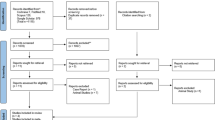Abstract
Data sources
Pubmed, Embase, Sciences Citation Index, Cochrane Central Register of Controlled Trials (CENTRAL) and grey literature database of SIGLE were searched from January 1, 1990 to August 20, 2011 with no language restrictions.
Study selection
Randomised controlled trials (RCTs) or quasi-RCTs in which the participants were healthy and received additional interventions to conventional orthodontic treatment for accelerating tooth movements were included. Subjects with defects in oral and maxillofacial regions (ie, cleft lip/palate), dental pathologies and medical conditions were excluded.
Data extraction and synthesis
Studies were selected by two independent reviewers and disagreements were resolved by discussion with a third reviewer. The primary outcomes included accumulative moved distance (AMD) or movement rate (MR) and time required to move the tooth to its destination. Secondary outcomes were pain improvement, anchorage loss, periodontal health, orthodontic caries, pulp vitality and root resorption. The reviewers performed statistical pooling, where possible, according to a priori criteria on the basis of comparability of patient type, treatments and outcomes measured and risk of bias. The reviewers tested for heterogeneity, publication bias and sensitivity. A quality assessment test was conducted to evaluate the method used to measure AMD.
Results
The authors selected seven RCTs and two quasi-RCTs, which included a total of 101 patients with an age range of 12-26.3 years. Eight studies compared four intervention methods to no intervention group (control group). From them, four studies assessed low laser therapy (LLL), two evaluated corticotomy (CC), one assessed electrical current therapy (EC) and one evaluated pulsed electromagnetic field (PEF). Another study compared dentoalveolar distraction (DAD) vs periodontal distraction (PDD).
Quality assessment scores showed that only two studies were of high quality, five studies were of medium quality, while two studies were of low quality. All studies, except one, compared left and right sides of the same participant (split mouth design), and measured the AMD.
The method for measuring AMD was reliable in three studies, relatively reliable in one study and unreliable in four studies. The authors only performed pooled AMD mean meta-analysis for the LLL studies. The meta-analysis showed pooled mean AMD of 0.32 (95% confidence interval (CI), 20.04, 0.68), 0.76 (95% CI, 20.14, 1.65), and 0.73 (95% CI, 20.68, 2.14) for one month, two months and three months, respectively. Two LLL studies showed no differences regarding periodontal health and two LLL studies showed no differences in root resorption between LLL intervention and control groups. Compared to control group, one study reported that CS had significantly higher MR and another study showed that CS exhibited larger AMD for one month, two months, three months and four months. Two studies revealed that CS did not show any difference in the periodontal health status. One study reported the EC showed significantly larger AMD for one month, whereas another study reported that PEF induced larger AMD for five + 0.6 months. DAD showed faster MR and less anchorage loss compared to PDD. Teeth remained vital in both DAD and PDD interventions and one out of six cases presented root resorption in the PDD group.
Conclusions
Among the five interventions corticotomy is effective and safe to accelerate orthodontic tooth movement, low-level laser therapy was unable to accelerate orthodontic tooth movement. The level of evidence does not support whether electrical current and pulsed electromagnetic fields are effective in accelerating orthodontic tooth movement and dentoalveolar or periodontal distraction is promising in accelerating orthodontic tooth movement.
Similar content being viewed by others
Log in or create a free account to read this content
Gain free access to this article, as well as selected content from this journal and more on nature.com
or
References
Skidmore KJ, Brook KJ, Thomson WM, Harding WJ . Factors influencing treatment time in orthodontic patients. Am J Orthod Dentofacial Orthop 2006; 129: 230–238.
Nimeri G, Kau CH, Abou-Kheir NS, Corona R . Acceleration of tooth movement during orthodontic treatment – a frontier in orthodontics. Prog Orthod 2013; 14: 42.
Riedmann T, Georg T, Berg R . Adult patients' view of orthodontic treatment outcome compared to professional assessments. J Orofac Orthop 1999; 60: 308–320.
Mavreas D, Athanasiou AE . Factors affecting the duration of orthodontic treatment: a systematic review. Eur J Orthod 2008; 30: 386–395.
Author information
Authors and Affiliations
Additional information
Address for correspondence: Dr Wenli Lai, State Key Laboratory of Oral Diseases, Department of Orthodontics, West China School of Stomatology, Sichuan University, No. 14, Section 3, Ren Min Nan Road, Chengdu, Sichuan 610041, the People's Republic of China. E-mail: wenlilai@hotmail.com.
Long H, Pyakurel U, Wang Y, Liao L, Zhou Y, Lai W. Interventions for accelerating orthodontic tooth movement: a systematic review. Angle Orthod 2013; 83: 164–171. Epub 2012/06/23. doi: 10.2319/031512-224.1. PubMed PMID: 22720793.
Rights and permissions
About this article
Cite this article
Abdallah, MN., Flores-Mir, C. Are interventions for accelerating orthodontic tooth movement effective?. Evid Based Dent 15, 116–117 (2014). https://doi.org/10.1038/sj.ebd.6401064
Published:
Issue date:
DOI: https://doi.org/10.1038/sj.ebd.6401064



